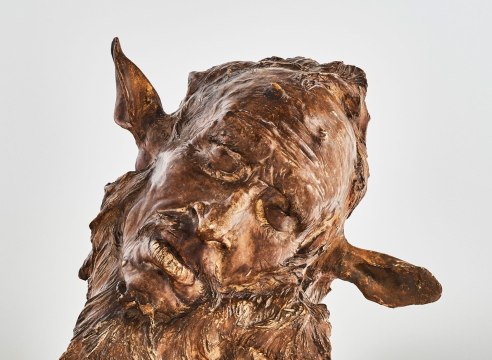
Inventory Number DOT030
Size 13.75" H x 8" W
Material Porcelain
Period Art Nouveau
Country of Origin France
Year Made c1907
Status SOLD
The simplicity of this vessel’s shape becomes a canvas on which the complexity of the glaze can be explored. The combination of the green, brown, and white glazes that subtly reveal themselves through fissures formed by contraction in the kiln exemplifies Doat’s mastery of the firing process.
-------
Trained at the École des Arts Décoratifs in Limoges and at the École des Beaux Arts, Paris, under the sculptor Augustin Alexandre Dumont, Taxile Doat (1851-1939) is acknowledged today as a true master of grand feu porcelain and stoneware. In 1877, at the age of twenty-six, he joined the Manufacture Nationale de Sèvres where he remained employed until 1905. Throughout his time there he kept a private studio in the city of Sèvres, named the Villa Kaolin, after the essential ingredient in true porcelain.[i] Doat was also granted a personal atelier within the Sèvres factory where, within the firm's design parameters, he was free to experiment with form and decoration.
Fascinated by nature and possessing a reverence for the classical past, Doat managed to successfully blend these competing idioms in his ceramics. Using shapes derived from fruits and gourds, likely inspired by Japanese prototypes, as well as classically-inspired forms and decorative cameos, he was able to balance the nineteenth-century tastes for naturalism and classicism.[ii] He was among the few highly regarded French ceramists who made a name for themselves through pâte-sur-pâte decoration, a technique of creating translucent low-relief compositions from layers of porcelain slip. Developed at Sèvres by Marc-Louis Solon in the mid-nineteenth century, the method became central to Doat's work, both at the manufactory and in his own studio. The classical motifs done in this manner often served to create unusual juxtapositions with Japanese-inspired forms and special high-fired glazes. Through his use of disparate design sources and ability to combine different types of clay and glaze effects, Doat managed to create something entirely idiosyncratic and new.
Doat was known for his experimentation with highly-specialized decoration and high-temperature firing techniques, in stoneware and porcelain, sometimes combining the two. His grand feu porcelains were the most difficult and therefore the most expensive to produce. While many artists of the period closely guarded how their work was made, he was one of the few who published on kiln technology, clays, and glaze formulas, probably to the dismay of his employers at Sevres. His reputation brought him to the attention of the American ceramist Adelaide Robineau and her husband Samuel who published his writings in Keramic Studio and later encouraged him to join them at University City in St. Louis, Missouri. It came, perhaps, as little surprise that Doat had problems with the administration at Sèvres, which had actually forbidden employees from working independently. Doat’s continual refusal to obey this rule, and probably the publication of proprietary formulas for clay and glazes, eventually led to his dismissal in 1905.
Throughout much of Europe, and especially in France, the late-nineteenth century was a period of transformation that radically reshaped the way ceramics were conceived. No longer simply a utilitarian pursuit, potters combined the artistic impulses of the avant-garde with Japanese aesthetics and sought to lift pottery from the realm of pure practicality to something worthy of the label “art.” Vase Balustre of 1907 demonstrates Doat’s synthesis of classical forms with Asian glaze aesthetics, and highlights his technical proficiency. Like many of the Japanese wares shown in France--and certainly reminiscent of the work of the Carriés school--the simplicity of the vessel’s shape becomes a canvas on which the complexity of the glaze can be explored. Here, however, instead of relying on Japanese forms for inspiration, Doat looks to the classical past and combines Occident and Orient into a single vessel. The combination of the green, brown, and white glazes that subtly reveal themselves through fissures formed by contraction in the kiln exemplifies Doat’s mastery of the firing process. As he himself put it, “a ceramist does not exist without his kiln any more than a violinist without his violin.”[iii]
Doat departed France in 1909 and accepted the Robineaus’ invitation to work as the Director of the School of Ceramic Art at the Art Institute and the University City Pottery in Missouri.[iv] The pottery's work was exhibited at the International Exposition of 1911 in Turin, Italy where it was awarded the Grand Prize in competition with all the European potteries. Doat returned to France in 1915 and continued producing ceramics until his death in May 1938.
A pioneering French ceramicist, Taxile Doat is acknowledged as one of the most influential European potters of the late-nineteenth century. His interest in Japanese pottery led him to create novel shapes, often based on natural forms including this gourd-shaped vase, inspired by vegetable-shaped Japanese sake bottles. Doat also spent much of his career working to perfect the dramatic flambé and crystalline glazes which mark his most experimental works. Both creative impulses are evident in a gourd-shaped bottle, exhibited at the Paris Salon of 1902, which features a russet and black crystalline glaze that drip downs the body of the vase.
[i] Etienne Tornier, Sévres at the Turn of the 20th Century: Power, Attraction and Creation (New York: Jason Jacques Gallery, 2015), 9.
[ii] Jennifer Hawkins Opie, “The New Ceramics: Engaging with the Spirit,” in Art Nouveau: 1890-1914 (London: V&A Publications, 2000), 193.
[iii] Taxile Doat, Grand Feu Ceramics: A Practical Treatise on the Making of Fine Porcelain and Grès (Syracuse, New York: Keramic Studio Publishing Company, 1905), 7.
[iv] For a summary of Doat’s time in St. Louis, see: David H. Conradsen and Ellen Denker, University City Ceramics: Art Pottery of the American Woman’s League (St. Louis, St. Louis Art Museum, 2004).
SIGNATURE
Painted "DOAT, SEVRES, 1907" to the underside.